The Impact of Neurology on Social Psychology: Key Concepts Explored
VerifiedAdded on 2019/09/30
|6
|2200
|127
Essay
AI Summary
This paper provides an in-depth exploration of the significant relationship between neurology and social psychology. It delves into key concepts such as the bystander effect, attribution theory, stereotyping, cognitive dissonance, and evolutionary psychology, illustrating how neurological insights enhance our understanding of human behavior and mental processes. The paper examines the causes and implications of each concept, offering real-world examples and supporting research. It emphasizes the impact of neurological advancements on social and behavioral sciences, and it highlights how these insights can be utilized in addressing psychological challenges. The paper also discusses the role of diffusion of responsibility, pluralistic ignorance, and how these concepts shape social interactions. Furthermore, it explores internal and external attributions, and how these attributions affect our perceptions. The paper also explores stereotyping, its causes, and its impact on social relationships, as well as the core principles of cognitive dissonance and evolutionary psychology.
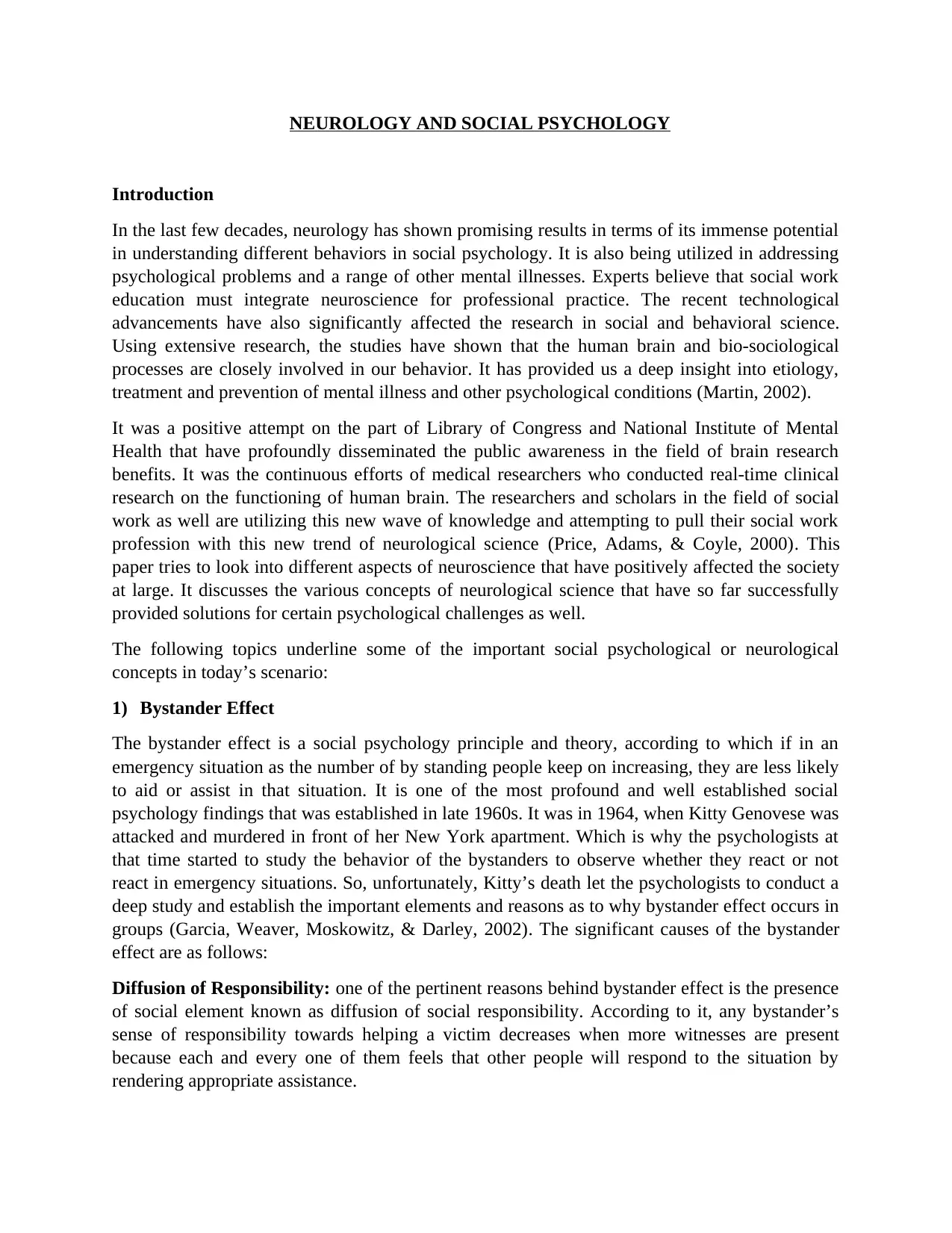
NEUROLOGY AND SOCIAL PSYCHOLOGY
Introduction
In the last few decades, neurology has shown promising results in terms of its immense potential
in understanding different behaviors in social psychology. It is also being utilized in addressing
psychological problems and a range of other mental illnesses. Experts believe that social work
education must integrate neuroscience for professional practice. The recent technological
advancements have also significantly affected the research in social and behavioral science.
Using extensive research, the studies have shown that the human brain and bio-sociological
processes are closely involved in our behavior. It has provided us a deep insight into etiology,
treatment and prevention of mental illness and other psychological conditions (Martin, 2002).
It was a positive attempt on the part of Library of Congress and National Institute of Mental
Health that have profoundly disseminated the public awareness in the field of brain research
benefits. It was the continuous efforts of medical researchers who conducted real-time clinical
research on the functioning of human brain. The researchers and scholars in the field of social
work as well are utilizing this new wave of knowledge and attempting to pull their social work
profession with this new trend of neurological science (Price, Adams, & Coyle, 2000). This
paper tries to look into different aspects of neuroscience that have positively affected the society
at large. It discusses the various concepts of neurological science that have so far successfully
provided solutions for certain psychological challenges as well.
The following topics underline some of the important social psychological or neurological
concepts in today’s scenario:
1) Bystander Effect
The bystander effect is a social psychology principle and theory, according to which if in an
emergency situation as the number of by standing people keep on increasing, they are less likely
to aid or assist in that situation. It is one of the most profound and well established social
psychology findings that was established in late 1960s. It was in 1964, when Kitty Genovese was
attacked and murdered in front of her New York apartment. Which is why the psychologists at
that time started to study the behavior of the bystanders to observe whether they react or not
react in emergency situations. So, unfortunately, Kitty’s death let the psychologists to conduct a
deep study and establish the important elements and reasons as to why bystander effect occurs in
groups (Garcia, Weaver, Moskowitz, & Darley, 2002). The significant causes of the bystander
effect are as follows:
Diffusion of Responsibility: one of the pertinent reasons behind bystander effect is the presence
of social element known as diffusion of social responsibility. According to it, any bystander’s
sense of responsibility towards helping a victim decreases when more witnesses are present
because each and every one of them feels that other people will respond to the situation by
rendering appropriate assistance.
Introduction
In the last few decades, neurology has shown promising results in terms of its immense potential
in understanding different behaviors in social psychology. It is also being utilized in addressing
psychological problems and a range of other mental illnesses. Experts believe that social work
education must integrate neuroscience for professional practice. The recent technological
advancements have also significantly affected the research in social and behavioral science.
Using extensive research, the studies have shown that the human brain and bio-sociological
processes are closely involved in our behavior. It has provided us a deep insight into etiology,
treatment and prevention of mental illness and other psychological conditions (Martin, 2002).
It was a positive attempt on the part of Library of Congress and National Institute of Mental
Health that have profoundly disseminated the public awareness in the field of brain research
benefits. It was the continuous efforts of medical researchers who conducted real-time clinical
research on the functioning of human brain. The researchers and scholars in the field of social
work as well are utilizing this new wave of knowledge and attempting to pull their social work
profession with this new trend of neurological science (Price, Adams, & Coyle, 2000). This
paper tries to look into different aspects of neuroscience that have positively affected the society
at large. It discusses the various concepts of neurological science that have so far successfully
provided solutions for certain psychological challenges as well.
The following topics underline some of the important social psychological or neurological
concepts in today’s scenario:
1) Bystander Effect
The bystander effect is a social psychology principle and theory, according to which if in an
emergency situation as the number of by standing people keep on increasing, they are less likely
to aid or assist in that situation. It is one of the most profound and well established social
psychology findings that was established in late 1960s. It was in 1964, when Kitty Genovese was
attacked and murdered in front of her New York apartment. Which is why the psychologists at
that time started to study the behavior of the bystanders to observe whether they react or not
react in emergency situations. So, unfortunately, Kitty’s death let the psychologists to conduct a
deep study and establish the important elements and reasons as to why bystander effect occurs in
groups (Garcia, Weaver, Moskowitz, & Darley, 2002). The significant causes of the bystander
effect are as follows:
Diffusion of Responsibility: one of the pertinent reasons behind bystander effect is the presence
of social element known as diffusion of social responsibility. According to it, any bystander’s
sense of responsibility towards helping a victim decreases when more witnesses are present
because each and every one of them feels that other people will respond to the situation by
rendering appropriate assistance.
Paraphrase This Document
Need a fresh take? Get an instant paraphrase of this document with our AI Paraphraser
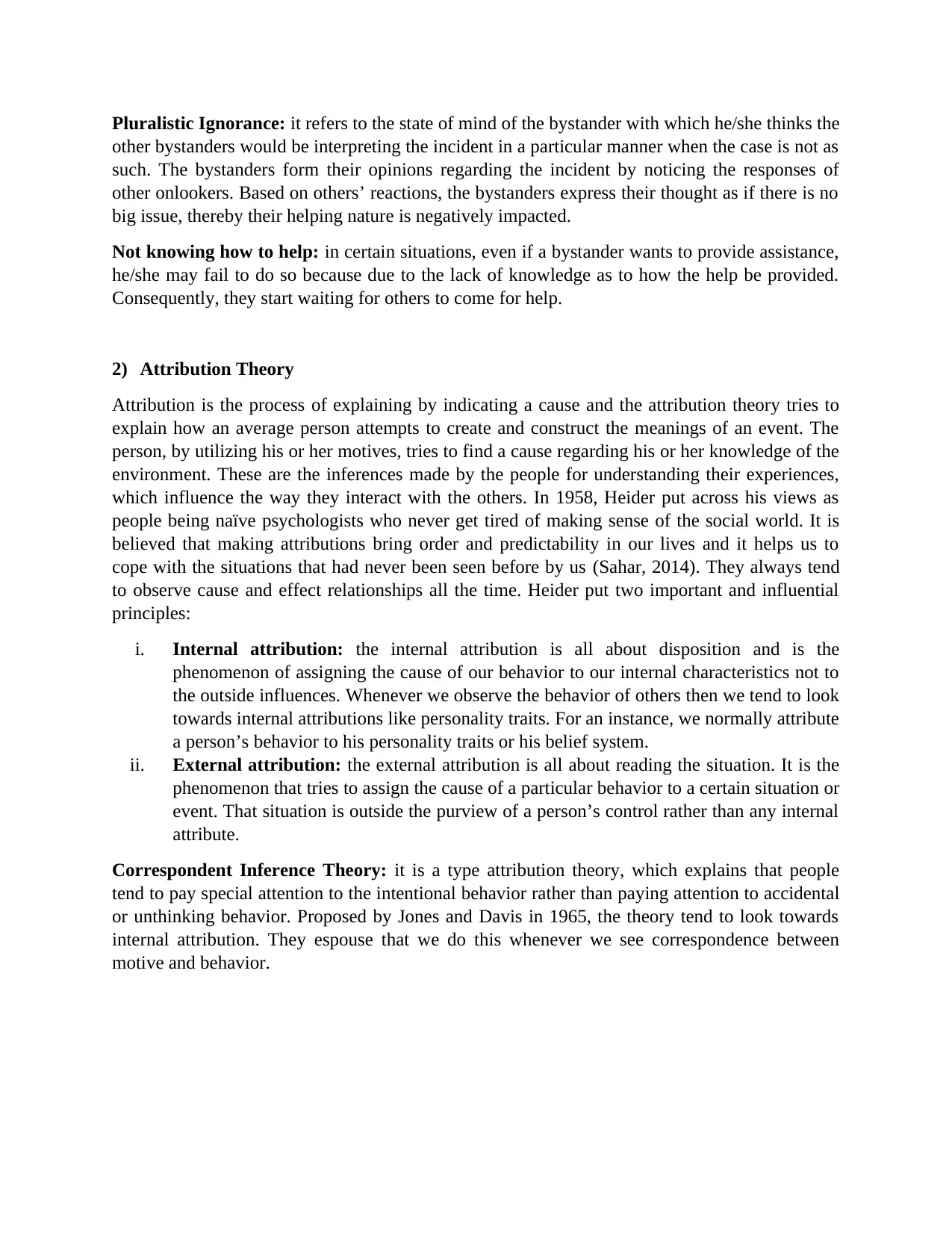
Pluralistic Ignorance: it refers to the state of mind of the bystander with which he/she thinks the
other bystanders would be interpreting the incident in a particular manner when the case is not as
such. The bystanders form their opinions regarding the incident by noticing the responses of
other onlookers. Based on others’ reactions, the bystanders express their thought as if there is no
big issue, thereby their helping nature is negatively impacted.
Not knowing how to help: in certain situations, even if a bystander wants to provide assistance,
he/she may fail to do so because due to the lack of knowledge as to how the help be provided.
Consequently, they start waiting for others to come for help.
2) Attribution Theory
Attribution is the process of explaining by indicating a cause and the attribution theory tries to
explain how an average person attempts to create and construct the meanings of an event. The
person, by utilizing his or her motives, tries to find a cause regarding his or her knowledge of the
environment. These are the inferences made by the people for understanding their experiences,
which influence the way they interact with the others. In 1958, Heider put across his views as
people being naïve psychologists who never get tired of making sense of the social world. It is
believed that making attributions bring order and predictability in our lives and it helps us to
cope with the situations that had never been seen before by us (Sahar, 2014). They always tend
to observe cause and effect relationships all the time. Heider put two important and influential
principles:
i. Internal attribution: the internal attribution is all about disposition and is the
phenomenon of assigning the cause of our behavior to our internal characteristics not to
the outside influences. Whenever we observe the behavior of others then we tend to look
towards internal attributions like personality traits. For an instance, we normally attribute
a person’s behavior to his personality traits or his belief system.
ii. External attribution: the external attribution is all about reading the situation. It is the
phenomenon that tries to assign the cause of a particular behavior to a certain situation or
event. That situation is outside the purview of a person’s control rather than any internal
attribute.
Correspondent Inference Theory: it is a type attribution theory, which explains that people
tend to pay special attention to the intentional behavior rather than paying attention to accidental
or unthinking behavior. Proposed by Jones and Davis in 1965, the theory tend to look towards
internal attribution. They espouse that we do this whenever we see correspondence between
motive and behavior.
other bystanders would be interpreting the incident in a particular manner when the case is not as
such. The bystanders form their opinions regarding the incident by noticing the responses of
other onlookers. Based on others’ reactions, the bystanders express their thought as if there is no
big issue, thereby their helping nature is negatively impacted.
Not knowing how to help: in certain situations, even if a bystander wants to provide assistance,
he/she may fail to do so because due to the lack of knowledge as to how the help be provided.
Consequently, they start waiting for others to come for help.
2) Attribution Theory
Attribution is the process of explaining by indicating a cause and the attribution theory tries to
explain how an average person attempts to create and construct the meanings of an event. The
person, by utilizing his or her motives, tries to find a cause regarding his or her knowledge of the
environment. These are the inferences made by the people for understanding their experiences,
which influence the way they interact with the others. In 1958, Heider put across his views as
people being naïve psychologists who never get tired of making sense of the social world. It is
believed that making attributions bring order and predictability in our lives and it helps us to
cope with the situations that had never been seen before by us (Sahar, 2014). They always tend
to observe cause and effect relationships all the time. Heider put two important and influential
principles:
i. Internal attribution: the internal attribution is all about disposition and is the
phenomenon of assigning the cause of our behavior to our internal characteristics not to
the outside influences. Whenever we observe the behavior of others then we tend to look
towards internal attributions like personality traits. For an instance, we normally attribute
a person’s behavior to his personality traits or his belief system.
ii. External attribution: the external attribution is all about reading the situation. It is the
phenomenon that tries to assign the cause of a particular behavior to a certain situation or
event. That situation is outside the purview of a person’s control rather than any internal
attribute.
Correspondent Inference Theory: it is a type attribution theory, which explains that people
tend to pay special attention to the intentional behavior rather than paying attention to accidental
or unthinking behavior. Proposed by Jones and Davis in 1965, the theory tend to look towards
internal attribution. They espouse that we do this whenever we see correspondence between
motive and behavior.
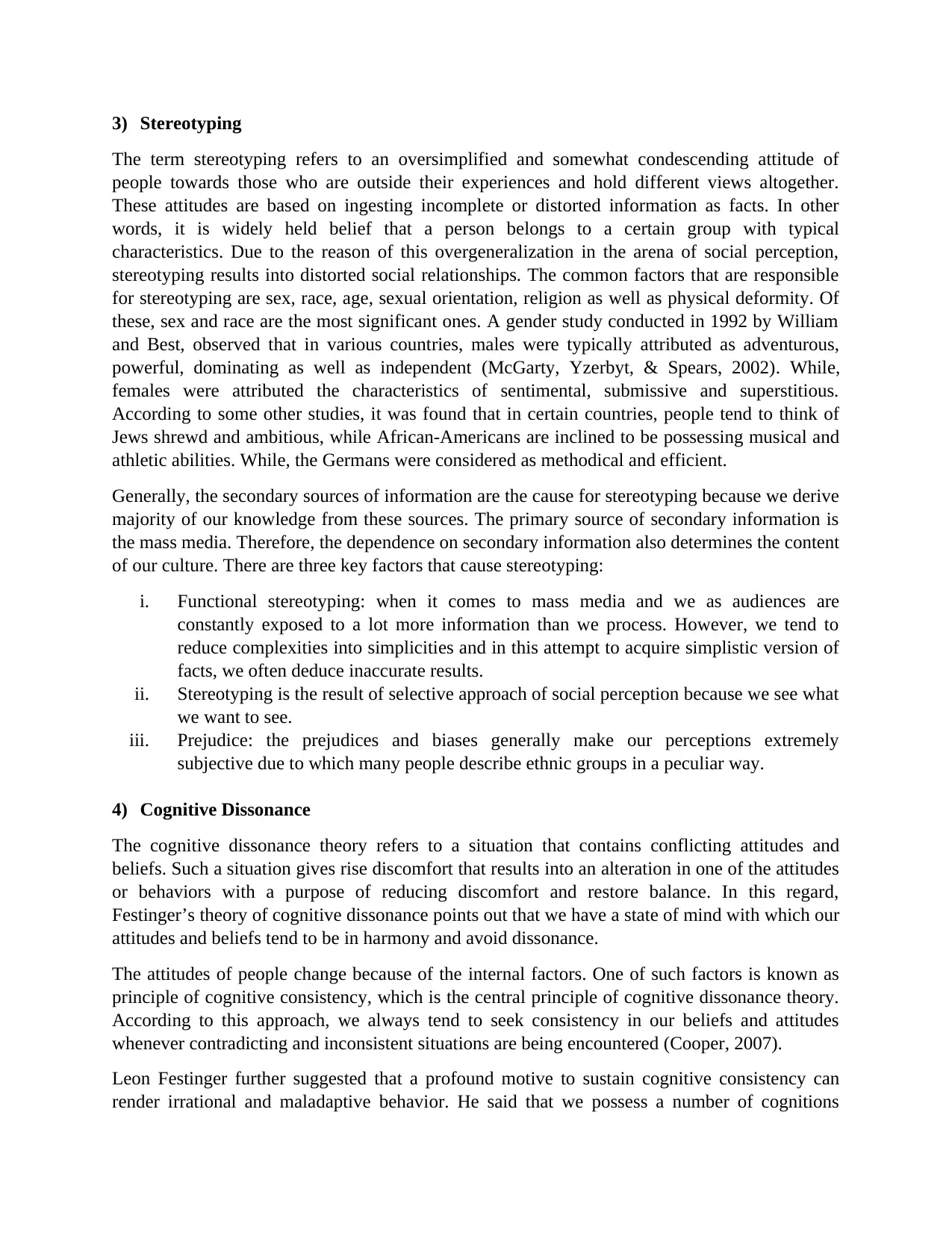
3) Stereotyping
The term stereotyping refers to an oversimplified and somewhat condescending attitude of
people towards those who are outside their experiences and hold different views altogether.
These attitudes are based on ingesting incomplete or distorted information as facts. In other
words, it is widely held belief that a person belongs to a certain group with typical
characteristics. Due to the reason of this overgeneralization in the arena of social perception,
stereotyping results into distorted social relationships. The common factors that are responsible
for stereotyping are sex, race, age, sexual orientation, religion as well as physical deformity. Of
these, sex and race are the most significant ones. A gender study conducted in 1992 by William
and Best, observed that in various countries, males were typically attributed as adventurous,
powerful, dominating as well as independent (McGarty, Yzerbyt, & Spears, 2002). While,
females were attributed the characteristics of sentimental, submissive and superstitious.
According to some other studies, it was found that in certain countries, people tend to think of
Jews shrewd and ambitious, while African-Americans are inclined to be possessing musical and
athletic abilities. While, the Germans were considered as methodical and efficient.
Generally, the secondary sources of information are the cause for stereotyping because we derive
majority of our knowledge from these sources. The primary source of secondary information is
the mass media. Therefore, the dependence on secondary information also determines the content
of our culture. There are three key factors that cause stereotyping:
i. Functional stereotyping: when it comes to mass media and we as audiences are
constantly exposed to a lot more information than we process. However, we tend to
reduce complexities into simplicities and in this attempt to acquire simplistic version of
facts, we often deduce inaccurate results.
ii. Stereotyping is the result of selective approach of social perception because we see what
we want to see.
iii. Prejudice: the prejudices and biases generally make our perceptions extremely
subjective due to which many people describe ethnic groups in a peculiar way.
4) Cognitive Dissonance
The cognitive dissonance theory refers to a situation that contains conflicting attitudes and
beliefs. Such a situation gives rise discomfort that results into an alteration in one of the attitudes
or behaviors with a purpose of reducing discomfort and restore balance. In this regard,
Festinger’s theory of cognitive dissonance points out that we have a state of mind with which our
attitudes and beliefs tend to be in harmony and avoid dissonance.
The attitudes of people change because of the internal factors. One of such factors is known as
principle of cognitive consistency, which is the central principle of cognitive dissonance theory.
According to this approach, we always tend to seek consistency in our beliefs and attitudes
whenever contradicting and inconsistent situations are being encountered (Cooper, 2007).
Leon Festinger further suggested that a profound motive to sustain cognitive consistency can
render irrational and maladaptive behavior. He said that we possess a number of cognitions
The term stereotyping refers to an oversimplified and somewhat condescending attitude of
people towards those who are outside their experiences and hold different views altogether.
These attitudes are based on ingesting incomplete or distorted information as facts. In other
words, it is widely held belief that a person belongs to a certain group with typical
characteristics. Due to the reason of this overgeneralization in the arena of social perception,
stereotyping results into distorted social relationships. The common factors that are responsible
for stereotyping are sex, race, age, sexual orientation, religion as well as physical deformity. Of
these, sex and race are the most significant ones. A gender study conducted in 1992 by William
and Best, observed that in various countries, males were typically attributed as adventurous,
powerful, dominating as well as independent (McGarty, Yzerbyt, & Spears, 2002). While,
females were attributed the characteristics of sentimental, submissive and superstitious.
According to some other studies, it was found that in certain countries, people tend to think of
Jews shrewd and ambitious, while African-Americans are inclined to be possessing musical and
athletic abilities. While, the Germans were considered as methodical and efficient.
Generally, the secondary sources of information are the cause for stereotyping because we derive
majority of our knowledge from these sources. The primary source of secondary information is
the mass media. Therefore, the dependence on secondary information also determines the content
of our culture. There are three key factors that cause stereotyping:
i. Functional stereotyping: when it comes to mass media and we as audiences are
constantly exposed to a lot more information than we process. However, we tend to
reduce complexities into simplicities and in this attempt to acquire simplistic version of
facts, we often deduce inaccurate results.
ii. Stereotyping is the result of selective approach of social perception because we see what
we want to see.
iii. Prejudice: the prejudices and biases generally make our perceptions extremely
subjective due to which many people describe ethnic groups in a peculiar way.
4) Cognitive Dissonance
The cognitive dissonance theory refers to a situation that contains conflicting attitudes and
beliefs. Such a situation gives rise discomfort that results into an alteration in one of the attitudes
or behaviors with a purpose of reducing discomfort and restore balance. In this regard,
Festinger’s theory of cognitive dissonance points out that we have a state of mind with which our
attitudes and beliefs tend to be in harmony and avoid dissonance.
The attitudes of people change because of the internal factors. One of such factors is known as
principle of cognitive consistency, which is the central principle of cognitive dissonance theory.
According to this approach, we always tend to seek consistency in our beliefs and attitudes
whenever contradicting and inconsistent situations are being encountered (Cooper, 2007).
Leon Festinger further suggested that a profound motive to sustain cognitive consistency can
render irrational and maladaptive behavior. He said that we possess a number of cognitions
⊘ This is a preview!⊘
Do you want full access?
Subscribe today to unlock all pages.

Trusted by 1+ million students worldwide
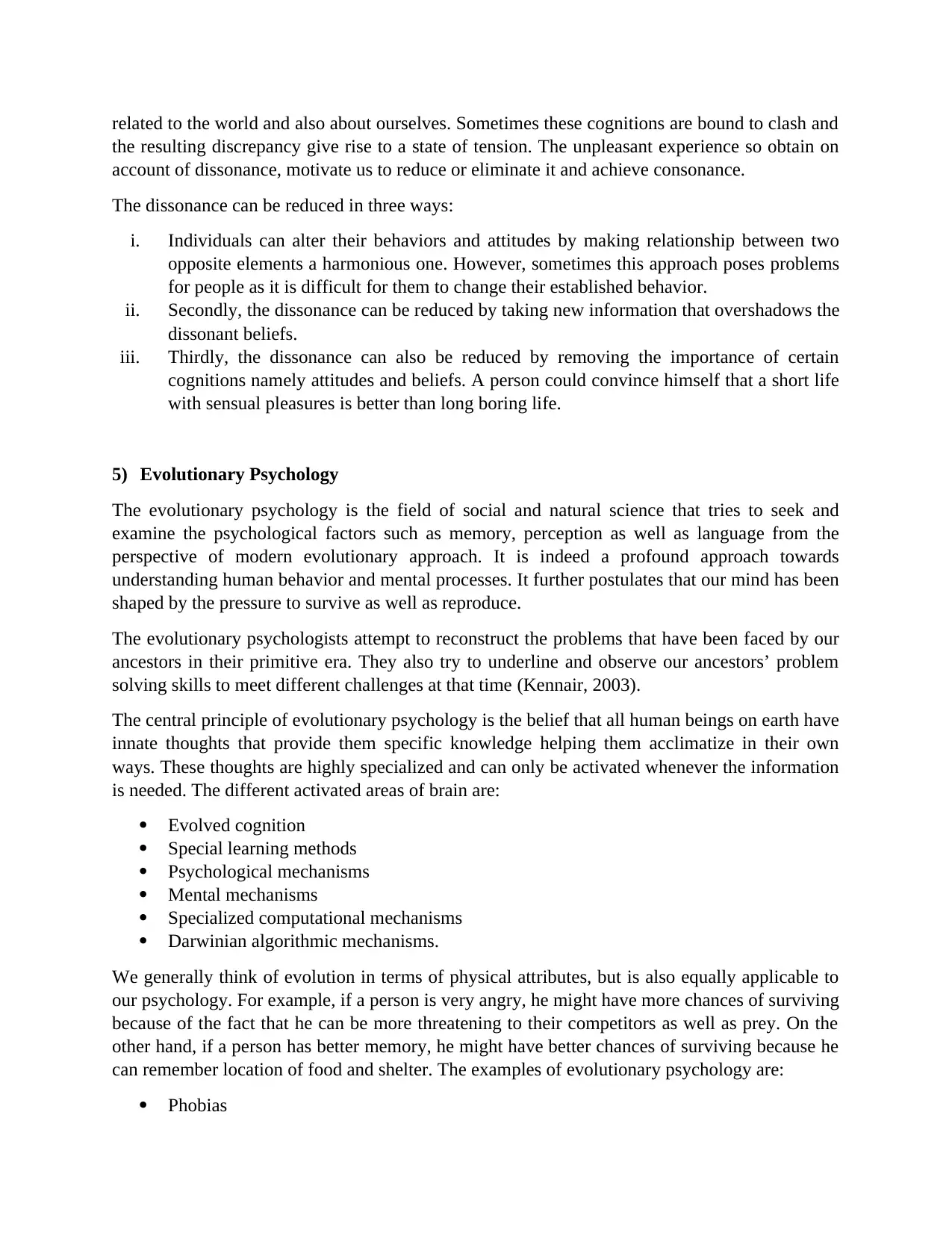
related to the world and also about ourselves. Sometimes these cognitions are bound to clash and
the resulting discrepancy give rise to a state of tension. The unpleasant experience so obtain on
account of dissonance, motivate us to reduce or eliminate it and achieve consonance.
The dissonance can be reduced in three ways:
i. Individuals can alter their behaviors and attitudes by making relationship between two
opposite elements a harmonious one. However, sometimes this approach poses problems
for people as it is difficult for them to change their established behavior.
ii. Secondly, the dissonance can be reduced by taking new information that overshadows the
dissonant beliefs.
iii. Thirdly, the dissonance can also be reduced by removing the importance of certain
cognitions namely attitudes and beliefs. A person could convince himself that a short life
with sensual pleasures is better than long boring life.
5) Evolutionary Psychology
The evolutionary psychology is the field of social and natural science that tries to seek and
examine the psychological factors such as memory, perception as well as language from the
perspective of modern evolutionary approach. It is indeed a profound approach towards
understanding human behavior and mental processes. It further postulates that our mind has been
shaped by the pressure to survive as well as reproduce.
The evolutionary psychologists attempt to reconstruct the problems that have been faced by our
ancestors in their primitive era. They also try to underline and observe our ancestors’ problem
solving skills to meet different challenges at that time (Kennair, 2003).
The central principle of evolutionary psychology is the belief that all human beings on earth have
innate thoughts that provide them specific knowledge helping them acclimatize in their own
ways. These thoughts are highly specialized and can only be activated whenever the information
is needed. The different activated areas of brain are:
Evolved cognition
Special learning methods
Psychological mechanisms
Mental mechanisms
Specialized computational mechanisms
Darwinian algorithmic mechanisms.
We generally think of evolution in terms of physical attributes, but is also equally applicable to
our psychology. For example, if a person is very angry, he might have more chances of surviving
because of the fact that he can be more threatening to their competitors as well as prey. On the
other hand, if a person has better memory, he might have better chances of surviving because he
can remember location of food and shelter. The examples of evolutionary psychology are:
Phobias
the resulting discrepancy give rise to a state of tension. The unpleasant experience so obtain on
account of dissonance, motivate us to reduce or eliminate it and achieve consonance.
The dissonance can be reduced in three ways:
i. Individuals can alter their behaviors and attitudes by making relationship between two
opposite elements a harmonious one. However, sometimes this approach poses problems
for people as it is difficult for them to change their established behavior.
ii. Secondly, the dissonance can be reduced by taking new information that overshadows the
dissonant beliefs.
iii. Thirdly, the dissonance can also be reduced by removing the importance of certain
cognitions namely attitudes and beliefs. A person could convince himself that a short life
with sensual pleasures is better than long boring life.
5) Evolutionary Psychology
The evolutionary psychology is the field of social and natural science that tries to seek and
examine the psychological factors such as memory, perception as well as language from the
perspective of modern evolutionary approach. It is indeed a profound approach towards
understanding human behavior and mental processes. It further postulates that our mind has been
shaped by the pressure to survive as well as reproduce.
The evolutionary psychologists attempt to reconstruct the problems that have been faced by our
ancestors in their primitive era. They also try to underline and observe our ancestors’ problem
solving skills to meet different challenges at that time (Kennair, 2003).
The central principle of evolutionary psychology is the belief that all human beings on earth have
innate thoughts that provide them specific knowledge helping them acclimatize in their own
ways. These thoughts are highly specialized and can only be activated whenever the information
is needed. The different activated areas of brain are:
Evolved cognition
Special learning methods
Psychological mechanisms
Mental mechanisms
Specialized computational mechanisms
Darwinian algorithmic mechanisms.
We generally think of evolution in terms of physical attributes, but is also equally applicable to
our psychology. For example, if a person is very angry, he might have more chances of surviving
because of the fact that he can be more threatening to their competitors as well as prey. On the
other hand, if a person has better memory, he might have better chances of surviving because he
can remember location of food and shelter. The examples of evolutionary psychology are:
Phobias
Paraphrase This Document
Need a fresh take? Get an instant paraphrase of this document with our AI Paraphraser

Stress
Relationships
Motivation
Survival instinct
Altruism
Parenthood
Relationships
Motivation
Survival instinct
Altruism
Parenthood
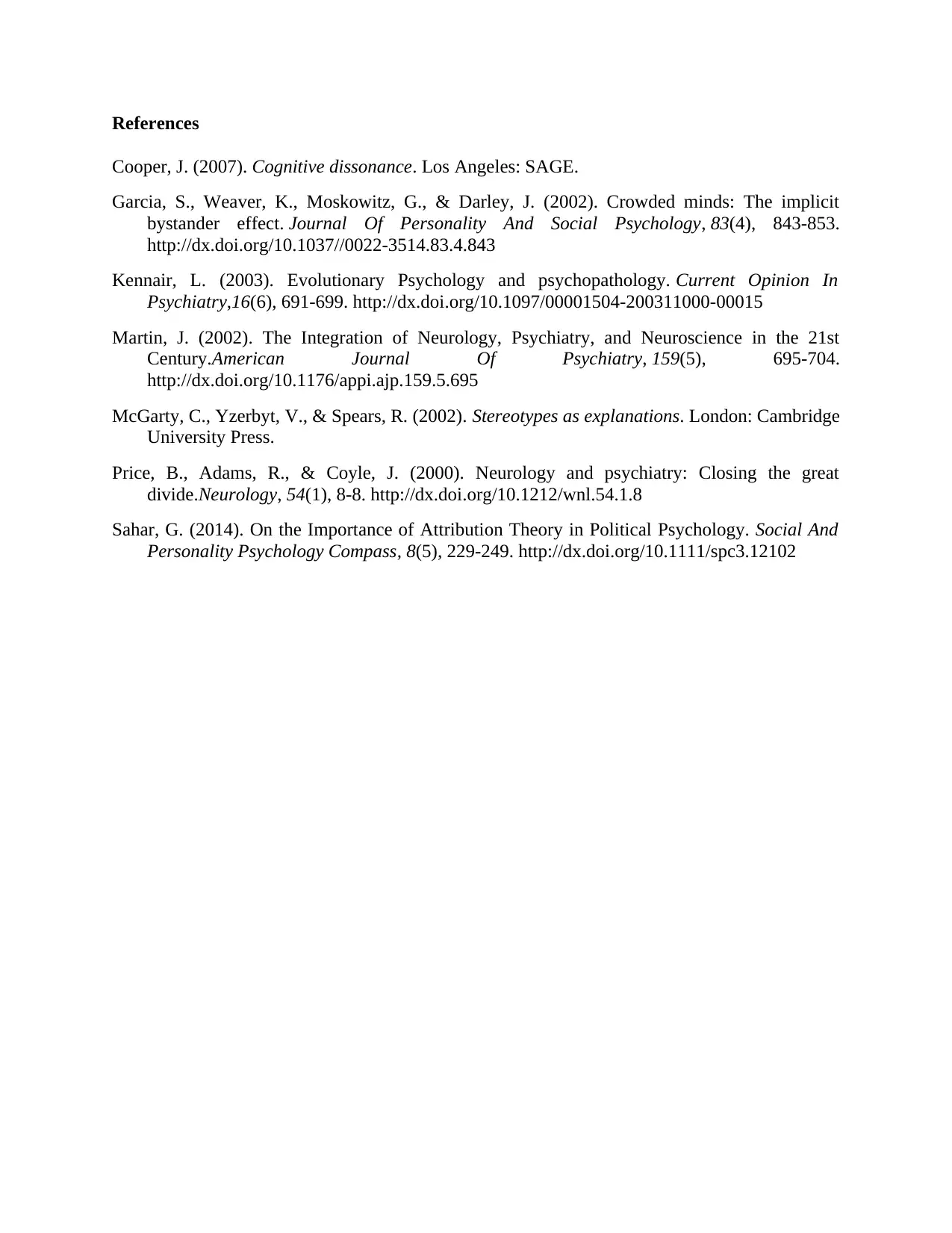
References
Cooper, J. (2007). Cognitive dissonance. Los Angeles: SAGE.
Garcia, S., Weaver, K., Moskowitz, G., & Darley, J. (2002). Crowded minds: The implicit
bystander effect. Journal Of Personality And Social Psychology, 83(4), 843-853.
http://dx.doi.org/10.1037//0022-3514.83.4.843
Kennair, L. (2003). Evolutionary Psychology and psychopathology. Current Opinion In
Psychiatry,16(6), 691-699. http://dx.doi.org/10.1097/00001504-200311000-00015
Martin, J. (2002). The Integration of Neurology, Psychiatry, and Neuroscience in the 21st
Century.American Journal Of Psychiatry, 159(5), 695-704.
http://dx.doi.org/10.1176/appi.ajp.159.5.695
McGarty, C., Yzerbyt, V., & Spears, R. (2002). Stereotypes as explanations. London: Cambridge
University Press.
Price, B., Adams, R., & Coyle, J. (2000). Neurology and psychiatry: Closing the great
divide.Neurology, 54(1), 8-8. http://dx.doi.org/10.1212/wnl.54.1.8
Sahar, G. (2014). On the Importance of Attribution Theory in Political Psychology. Social And
Personality Psychology Compass, 8(5), 229-249. http://dx.doi.org/10.1111/spc3.12102
Cooper, J. (2007). Cognitive dissonance. Los Angeles: SAGE.
Garcia, S., Weaver, K., Moskowitz, G., & Darley, J. (2002). Crowded minds: The implicit
bystander effect. Journal Of Personality And Social Psychology, 83(4), 843-853.
http://dx.doi.org/10.1037//0022-3514.83.4.843
Kennair, L. (2003). Evolutionary Psychology and psychopathology. Current Opinion In
Psychiatry,16(6), 691-699. http://dx.doi.org/10.1097/00001504-200311000-00015
Martin, J. (2002). The Integration of Neurology, Psychiatry, and Neuroscience in the 21st
Century.American Journal Of Psychiatry, 159(5), 695-704.
http://dx.doi.org/10.1176/appi.ajp.159.5.695
McGarty, C., Yzerbyt, V., & Spears, R. (2002). Stereotypes as explanations. London: Cambridge
University Press.
Price, B., Adams, R., & Coyle, J. (2000). Neurology and psychiatry: Closing the great
divide.Neurology, 54(1), 8-8. http://dx.doi.org/10.1212/wnl.54.1.8
Sahar, G. (2014). On the Importance of Attribution Theory in Political Psychology. Social And
Personality Psychology Compass, 8(5), 229-249. http://dx.doi.org/10.1111/spc3.12102
⊘ This is a preview!⊘
Do you want full access?
Subscribe today to unlock all pages.

Trusted by 1+ million students worldwide
1 out of 6
Related Documents
Your All-in-One AI-Powered Toolkit for Academic Success.
+13062052269
info@desklib.com
Available 24*7 on WhatsApp / Email
![[object Object]](/_next/static/media/star-bottom.7253800d.svg)
Unlock your academic potential
Copyright © 2020–2025 A2Z Services. All Rights Reserved. Developed and managed by ZUCOL.





